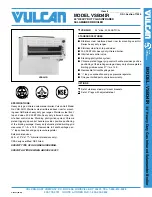
8
2.1.3
APPROVED VENTING MATERIALS
Exhaust Vent for Use for Dynaforce® Category ll or lV
Installations
1
Manufactured prefabricated UL/ ULC listed vent of AL29-
4C or equivalent, Single or Double Wall.
2
316L stainless steel is limited to use in applications where
there is no possibility of contaminants in the air such as
refrigerants, chlorine etc.
3
“BH” type.
4
PVC and CPVC Schedule 40 or 80 approved to ULC S636
5
PVC-DWV approved to comply with ANSI/ASTM D2665
(US Jurisdictions ONLY when permitted)
6
PVC Schedule 40 approved to comply with ANSI/ASTM
D1785 (US Jurisdictions ONLY when permitted)
7
CPVC Schedule 40 approved to comply with ANSI/ASTM
F441. (US Jurisdictions ONLY when permitted)
8
Polypropylene approved to comply with ULC S636 up to
12” diameter.
NOTE
1) Use of cellular core PVC (ASTM F891), cellular core
CPVC or Radel® (polyphenosulfone) in venting systems
is prohibited.
2) Covering non-metallic vent pipe and fittings with thermal
insulation is prohibited.
Table 4: Maximum Flue Temperature for Various Vent Materials
Vent Material
Maximum Flue Temperature [
o
F]
PVC
149
CPVC
194
Polypropylene
230
AL29-4C
300+, limited only by rating of seals
316L Stainless
Steel
300+, limited only by rating of seals
Stack temperature is 10-15
o
F above boiler inlet temperature
when operating at steady-state.
Vent material selection
When selecting vent material take into consideration that
appliances installed near a corrosive or potentially corrosive air
supply must be isolated from it or they will suffer damage to the
appliance and the venting system.
The corrosion resistance of AL29-4C is typically higher than
that of 316L. Always choose the venting system which best
satisfies the requirements of the application.
This recommendation does not supersede local codes or
the provision of the B149 in Canada or the National Fuel
Gas Code in the United States
Single wall air intake pipes are to be insulated 5 feet from wall
toward the interior of the building to minimize external
sweating.
Intake Air (Supply Air, or Fresh Air) Piping for Direct
Vent Applications
Air intake material must be of a type listed by a nationally
recognized testing agency.
1
PVC Non Foam Core Pipe.
2
CPVC Non Foam Core Pipe.
3
Polypropylene
4
ABS (Acrylonitrile-Butadiene-Styrene).
Single wall vent pipes to be insulated 5 feet from wall
toward the interior of the building to minimize external
sweating.
2.1.4
VENT TERMINATION CLEARANCES
•
Do not terminate the vent in a window well, stairwell,
alcove, courtyard or other recessed area. The vent
cannot terminate below grade. The bottom of the vent
terminal shall be located at least 12 inches (30cm)
above grade and above normal snow levels. In all
cases the appliance shall be installed in accordance
with local codes.
•
The vent outlet MUST NOT terminate below a forced
air inlet at any distance.
•
The vent cannot terminate below grade. Position the
vent termination where vapours will not damage walls
or plants or may otherwise be objectionable.
•
The vent terminal shall not be installed closer than 3
feet (1 m) from an inside corner of an L-shaped
structure, window well, stairwell, alcove, courtyard or
other recessed area as wind eddies could affect boiler
performance or cause recirculation.
•
DO NOT terminate closer than 4 feet (1.25m)
horizontally and vertically from any electric meter, gas
meter, regulator, relief valve, or other equipment. In
all cases local codes take precedence
•
Position terminations so they are not likely to be
damaged by foreign objects, or exposed to a build-up
of debris.
•
The vent piping must terminate in an elbow pointed
outward or away from the air inlet.
•
To avoid a blocked flue condition, keep the vent
cap/terminal clear of snow, ice, leaves, debris, etc.
•
Flue gases from this appliance may contain large
amounts of water vapour that will form a white plume
in winter. Plume could obstruct a window view.
•
Flue gas condensate can freeze on exterior walls or
on the vent cap. Frozen condensate on the vent cap
can result in a blocked flue condition. Some
discoloration to exterior building surfaces can be
expected. Adjacent brick or masonry surfaces should
be protected with a rust resistant sheet metal plate.
2.1.5
INLET CAP FOR ROOFTOP TERMINATION
The air inlet cap consists of two 90° elbows installed at the
point of termination for the air inlet pipe. The first 90°
elbow is installed on the rooftop at the highest vertical
point of the air inlet pipe and turned horizontal; the second
90° elbow is screened and is installed on the horizontal
outlet of the first elbow and turned down. A 90° elbow and
a 90° street elbow may be used to make this assembly. If
a straight piece of pipe is used between the two elbows, it
should not exceed 6" (150mm) in length.
Summary of Contents for DRH300
Page 2: ......
Page 6: ......
Page 38: ...32 13 Place toggle switch setting to REMOTE for remote operation if required...
Page 69: ...63 PART 12 EXPLODED VIEW 19 1 2 3 4 5 6 7 8 9 10 11 12 13 14 15 16 17 18 20...
Page 70: ...64 21 22 23 24 26 35 34 33 32 31 30 29 28 27 25 36 37 38 39 40 42 43 56...
Page 77: ...71 PART 13 ELECTRICAL DIAGRAMS...
Page 78: ...72...
Page 79: ...73...
Page 81: ...75...
Page 82: ...76...
Page 83: ...77...
Page 86: ......















































